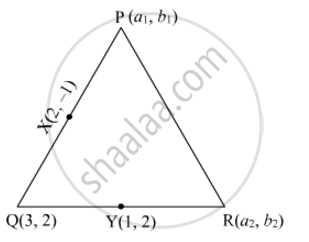Advertisements
Advertisements
प्रश्न
Find the area of the triangle PQR with Q(3,2) and the mid-points of the sides through Q being (2,−1) and (1,2).
उत्तर
Let the coordinates of the vertices P and R of ∆PQR be (a1, b1) and (a2, b2), respectively.

Suppose X(2, −1) is the midpoint of PQ.
Then,
`(2,-1)=((a_1+3)/2, (b_1+2)/2)`
`=>(a_1+3)/2=2 `
⇒ a1=1 and b1=−4
Therefore, the coordinates of P are (1, −4).
Again, suppose Y(1, 2) is the midpoint of QR.
Now,
`(1,2)=((a_2+3)/2,(b_2+2)/2)`
`=>(a_2+3)/2=1 `
⇒ a2=−1 and b2=2
Therefore, the coordinates of R are (−1, 2).
Thus, the vertices of ∆PQR are P(1,−4), Q(3, 2) and R(−1, 2).
Now,
Area of ∆PQR =`1/2`×[1(2−2)+3(2+4)−1(−4−2)]
=`1/2`(18+6)
=`1/2`(24)
=12
Thus, the area of ∆PQR is 12 square units.
संबंधित प्रश्न
Find the values of k so that the area of the triangle with vertices (k + 1, 1), (4, -3) and (7, -k) is 6 sq. units.
The vertices of ∆ABC = are A (4, 6), B(1, 5) and C(7, 2). A line is drawn to intersect sides AB and AC at D and E respectively such that `\frac{AD}{AB}=\frac{AE}{AC}=\frac{1}{4}` .Calculate the area of ∆ADE and compare it with the area of ∆ABC
Prove that the points (a, b + c), (b, c + a) and (c, a + b) are collinear
In each of the following find the value of 'k', for which the points are collinear.
(7, -2), (5, 1), (3, -k)
The two opposite vertices of a square are (− 1, 2) and (3, 2). Find the coordinates of the other two vertices.
The area of a triangle is 5 sq units. Two of its vertices are (2, 1) and (3, –2). If the third vertex is (`7/2`, y). Find the value of y
Prove that the points (a, b), (a1, b1) and (a −a1, b −b1) are collinear if ab1 = a1b.
Find the centroid of ΔABC whose vertices are A(-1, 0) B(5, -2) and C(8,2)
The points (0, 5), (0, –9) and (3, 6) are collinear.
Area of a triangle = `1/2` base × ______.
